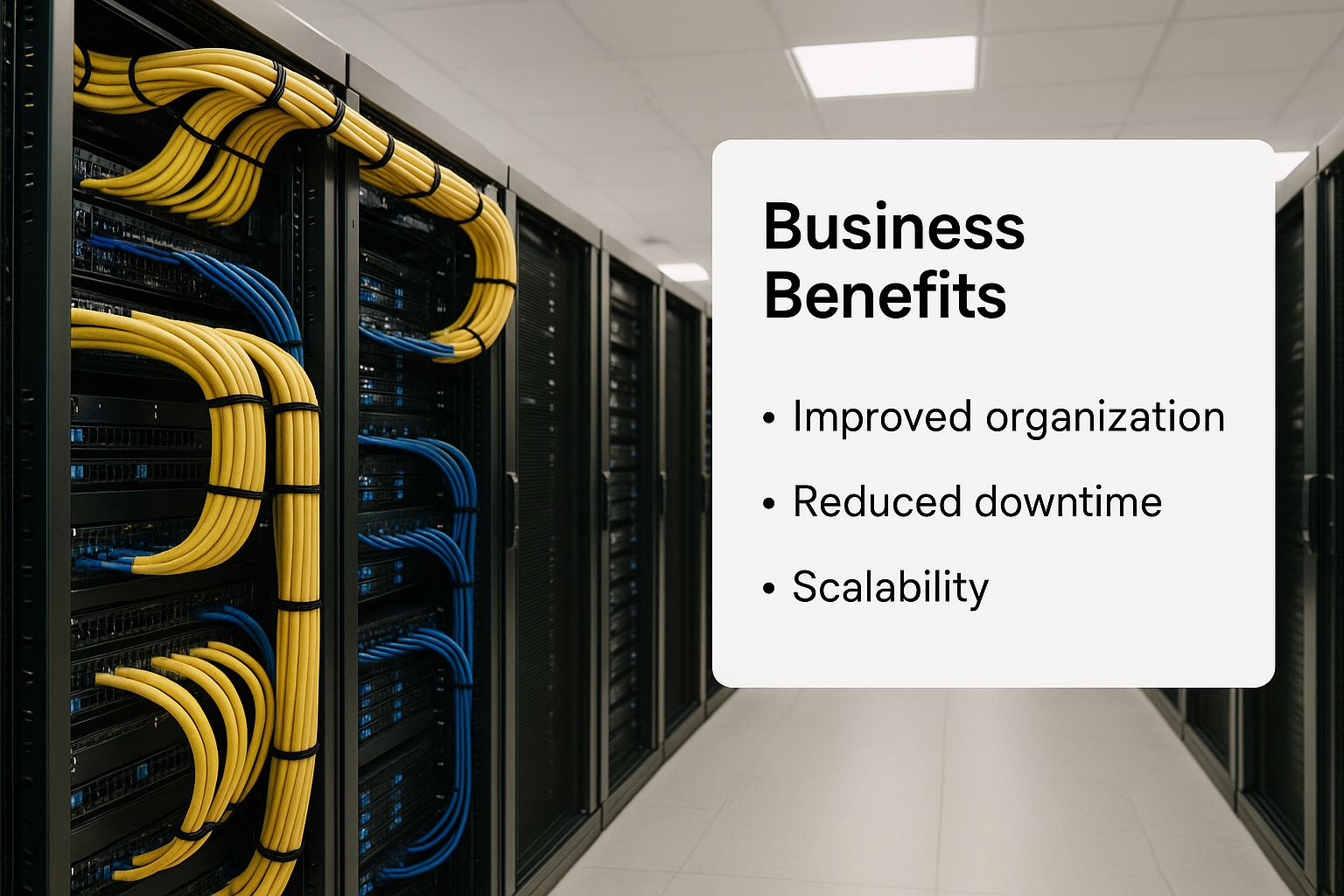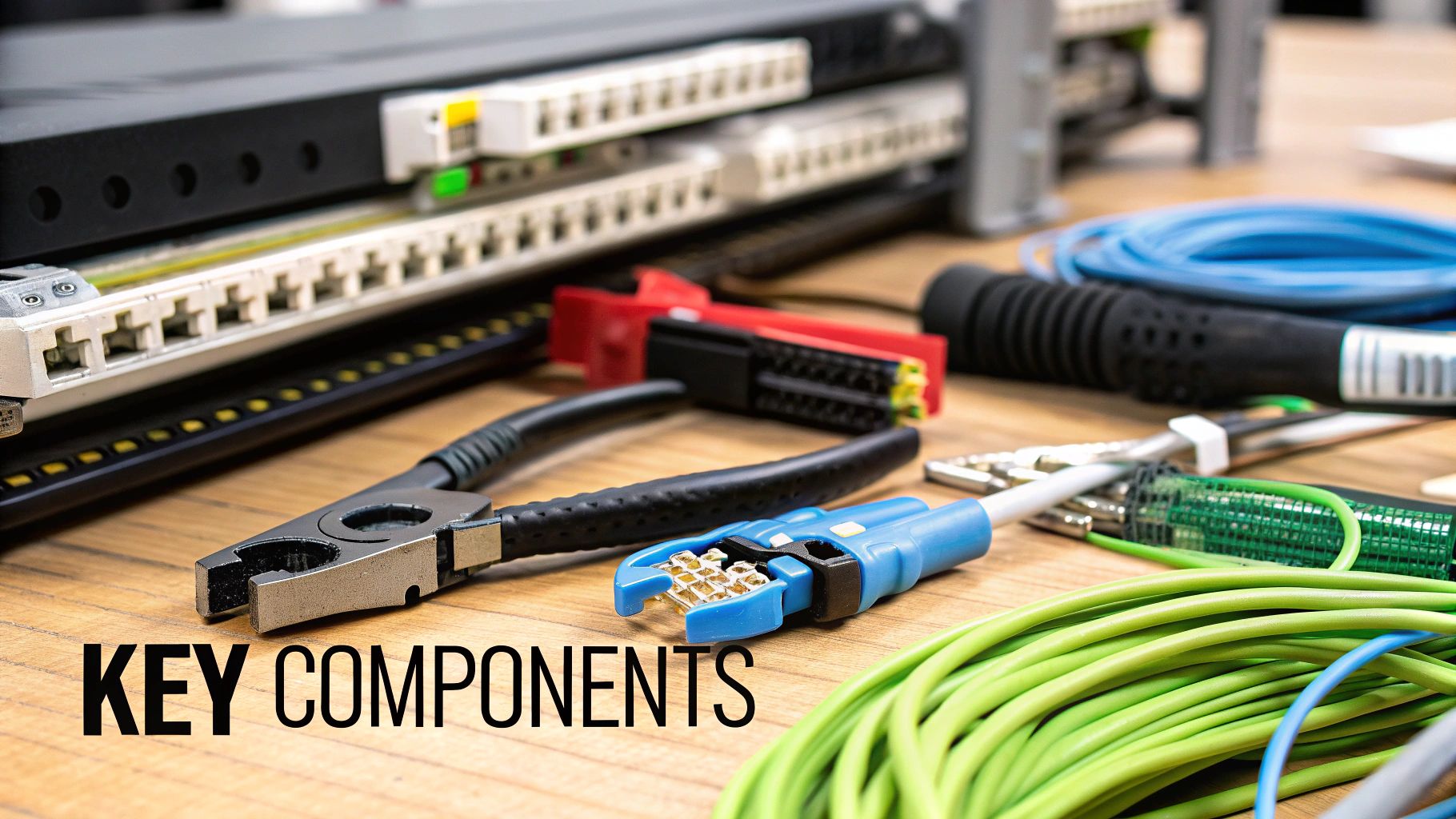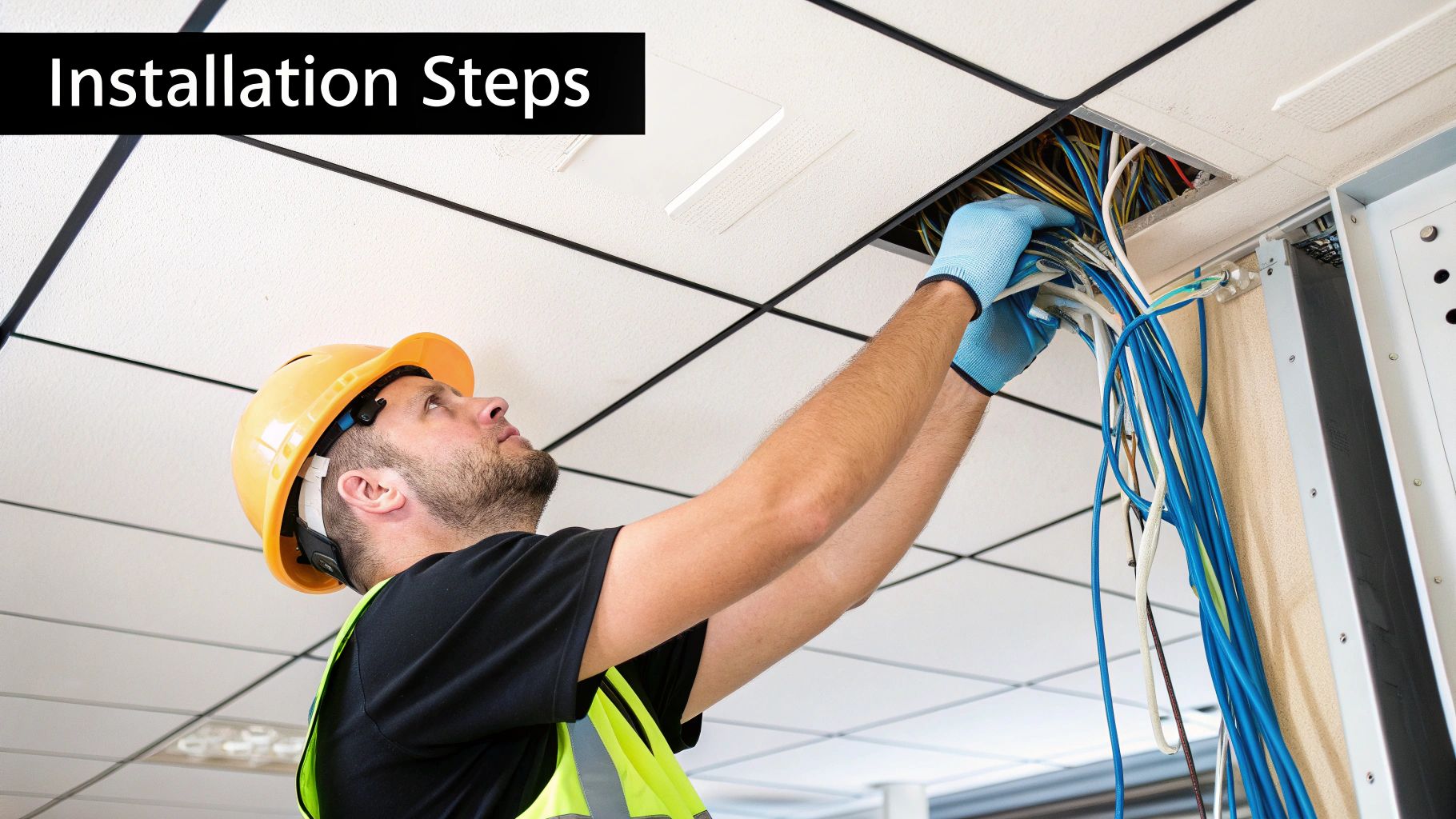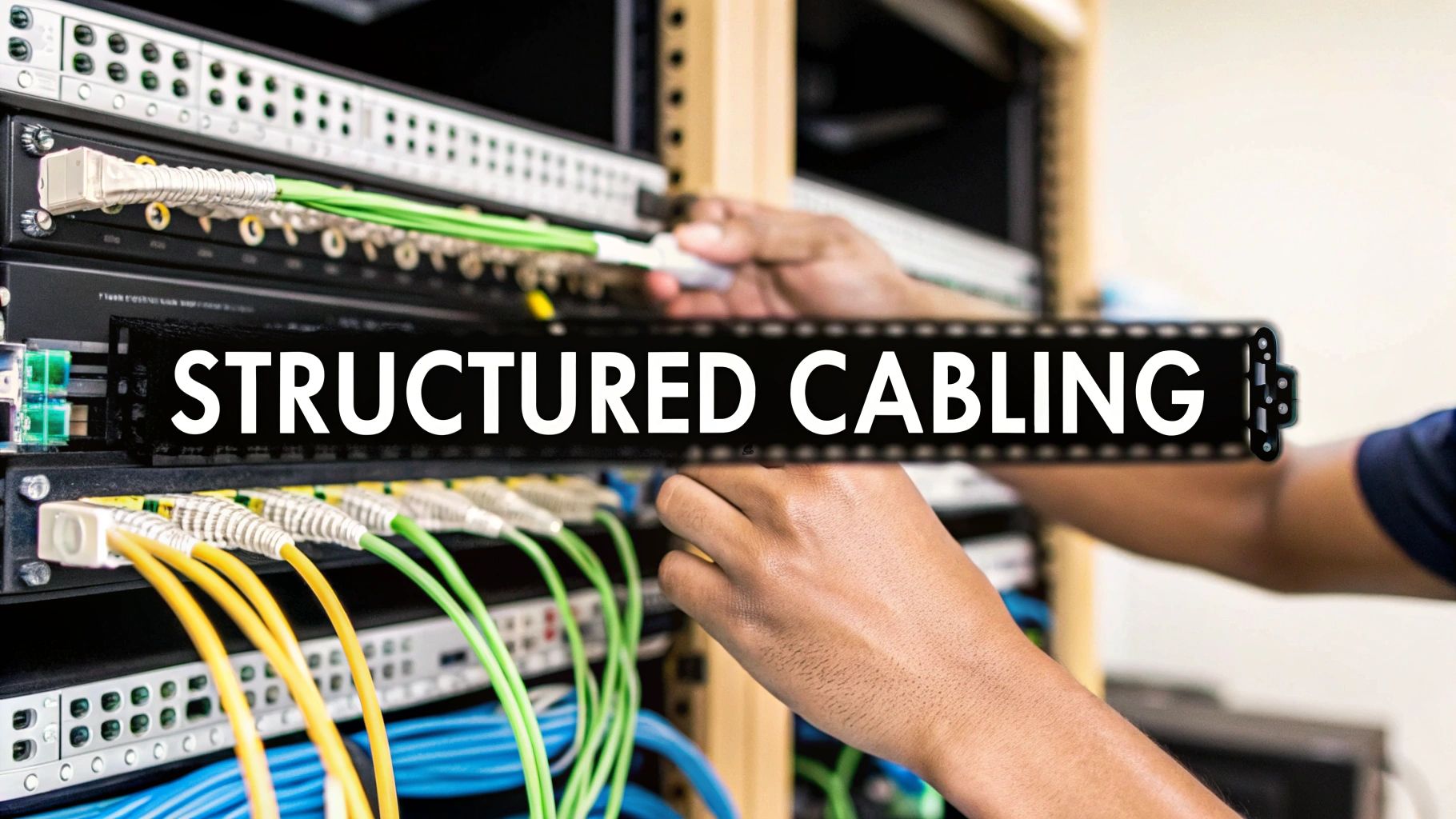Think of your business’s data network as its digital backbone. Structured cabling installers are the architects and builders of that essential framework. They replace the usual chaotic tangle of wires with a clean, organized, and standardized system that supports all your communication needs.
What Do Structured Cabling Installers Actually Build?
Imagine trying to build a modern office without a proper electrical grid. You could try running extension cords everywhere, but it would be a messy, unreliable, and frankly, dangerous setup that couldn’t possibly keep up with demand.
That’s what an unplanned network looks like. Structured cabling installers are the master electricians for your data, engineering a powerful, scalable grid for all your technology. They do far more than just pull cables through walls; they design a cohesive system that just works.
This system is the foundation for virtually everything your business does. It’s not just about plugging a computer into the internet. We’re talking about the infrastructure that powers your VoIP phones, your Wi-Fi access points, your PoE security camera systems, and even your building’s smart controls. Their work is what prevents the dreaded ‘server room spaghetti’—that nightmare of tangled cables that makes every IT issue a major headache.
From Blueprint to Backbone
The real magic of a professional installer is their methodical, forward-thinking approach. They don’t just build for today; they design a network that anticipates your needs for tomorrow. This means planning for future bandwidth demands and making it simple to integrate new devices down the road.
A well-designed system is a long-term asset. By planning for growth, installers ensure your network supports your business operations for years to come, maximizing your return on investment and minimizing future disruption.
A proper structured cabling installation is made up of six key subsystems that work together. Think of it like this: you have the entrance facility where services enter the building, the main equipment room (or server room), the backbone cabling that runs between floors, and the horizontal cabling that runs out to individual workstations. It’s this systematic approach that makes the entire network manageable.
The Services That Make It Happen
So, what exactly do these experts provide? Their services go beyond just running wires. They deliver a comprehensive solution that ensures your network is reliable, scalable, and easy to manage from day one.
Here’s a breakdown of the core services you can expect from a professional team and the value they bring to your business.
Core Services from Professional Installers
| Service Area | What They Do For You | Direct Business Impact |
|---|---|---|
| Network Design & Engineering | Create a detailed blueprint of your cabling infrastructure, planning for current needs and future growth. | Prevents costly network overhauls later. Ensures your infrastructure can scale with your business. |
| Cable Installation & Routing | Physically run and terminate copper (Cat6/6a) and fiber optic cables according to industry standards. | Guarantees reliable, high-speed connections. Minimizes signal interference and data loss. |
| Rack & Cabinet Setup | Assemble and organize server racks, patch panels, and cable management systems in your equipment rooms. | Creates a clean, accessible server room. Makes troubleshooting and maintenance 90% faster. |
| Testing & Certification | Use specialized tools to test every cable for performance, ensuring it meets or exceeds standards. | Verifies that every connection performs as expected. Eliminates guesswork and prevents future connectivity problems. |
| System Labeling & Documentation | Label every cable, port, and patch panel clearly and provide detailed network diagrams. | Dramatically simplifies IT management, moves, adds, and changes. Reduces downtime during network maintenance. |
Ultimately, bringing in a professional team transforms your network from a potential liability into a powerful asset that fuels your operations.
A Unified Platform for All Your Tech
One of the biggest wins from a structured cabling project is creating a single, unified platform for everything. Installers are pros at setting up systems that can handle a diverse range of technologies.
For example, they can run the cabling for advanced systems like VoIP phones or wireless access points that require specific performance guarantees. More complex projects might even involve high-speed fiber optics for connecting buildings or data-heavy departments. If you’re curious about what goes into that, our guide explains how to install fiber optic cable in detail.
In the end, these experts build a solid foundation that makes your entire technology ecosystem more reliable and ready for whatever comes next.
The Anatomy of a Professional Cabling System
To really get why structured cabling installers are so important, you need to peek behind the walls of a professionally wired building. What you’ll find isn’t just a chaotic jumble of wires. Instead, a structured cabling system is a meticulously organized infrastructure built from six distinct subsystems, each with a very specific job to do.
Think of it less like a tangled mess of Christmas lights and more like a city’s well-planned transportation grid. This organized approach is what turns your network from a constant headache into a reliable, high-performing asset. The infographic below shows just how this organized approach translates into real-world business benefits.

The neatly managed cables you see flowing through that data center aren’t just for looks. A clean, professional installation is fundamental to keeping your business running and makes future maintenance a whole lot simpler.
The Six Core Subsystems
Let’s break down the “anatomy” of this system, piece by piece, to see exactly how data gets from the outside world all the way to your desktop.
- Entrance Facility (EF)
This is literally where your building meets the outside world. It’s the demarcation point where the internet service provider’s network officially ends and your internal network begins. Think of it as the main port or harbor for every bit of data coming in or going out. - Equipment Room (ER)
The Equipment Room is the brain of the operation. This is where you’ll find the core networking gear—servers, routers, and the main switches. Sticking with our city analogy, this is the central train station or airport hub where all the major data routes converge. - Backbone Cabling
Often called vertical cabling, this is the network’s superhighway. It’s made up of high-capacity cables, usually fiber optic, that connect the main Equipment Room to smaller communications closets throughout the building. This is the heavy-duty infrastructure that ensures information can move quickly between different floors or departments.
Key Takeaway: A solid backbone isn’t just nice to have; it’s essential for performance. If your backbone is slow or unreliable, the entire network will feel sluggish, no matter how fast an individual user’s connection might be.
Connecting to the End User
The final three subsystems are all about closing that “last mile” and getting the connection directly to your team.
- Telecommunications Room (TR)
If the backbone is the highway, the TR (which is often just a closet) acts as the local off-ramp. It’s a dedicated space on each floor that bridges the high-speed backbone cabling with the cabling running to individual desks. Inside, patch panels and switches take that main feed and distribute it to all the nearby work areas. - Horizontal Cabling
This part of the system is like the local city streets. Horizontal cabling snakes out from the Telecommunications Room to the individual outlets at every desk or workstation. For these runs, copper cables like Cat6 or Cat6a are the industry standard. - Work Area (WA)
Finally, we arrive at our destination: the Work Area. This includes the wall outlets (or jacks) and the patch cords that physically connect a user’s device—be it a computer, VoIP phone, or printer—to the network. All that complex infrastructure comes together here to deliver one simple thing: a stable, working connection.
A huge part of managing this complex web of connections is keeping meticulous records. Professional structured cabling installers are religious about this, following essential documentation guidelines for field service to ensure every single cable and port is mapped out. This detailed paperwork makes future troubleshooting and upgrades incredibly faster and less disruptive—a core benefit you get from a professionally managed system.
The Real Cost of Cutting Corners on Installation

It’s a classic story we see all the time. Company A, laser-focused on the initial price tag, brings in a low-bid contractor to wire up their new office. The work gets done quickly and, most importantly, cheaply. But now, their team is plagued by constant connection drops, painfully slow speeds, and troubleshooting sessions that bring productivity to a dead stop. Every IT issue becomes a time-consuming mystery.
Company B, on the other hand, saw things differently. They understood their network was a vital business asset, not just an expense line. They invested in professional structured cabling installers and now enjoy a reliable, fast, and scalable network that just works. That upfront investment has paid for itself many times over in frustration avoided and time saved.
This isn’t just about messy wires versus clean ones. It’s about building an operational backbone that directly impacts your ability to do business.
The Hidden Price of a “Bargain” Installation
A rushed or poorly planned installation doesn’t just look bad; it creates a network riddled with hidden weak points. These issues often don’t surface right away, but when they do, they can turn what seemed like a smart saving into a major expense.
The fallout from a bad cabling job can be felt across the entire company:
- Crippling Downtime: Using uncertified cables or terminating them incorrectly is one of the top causes of network outages. For many businesses, even a few hours offline can mean thousands of dollars in lost revenue and wasted wages.
- Lost Productivity: When your team is stuck waiting for large files to transfer or battling a laggy connection, they aren’t being productive. These seemingly small delays add up to a staggering amount of wasted time over the year.
- Exhausting Maintenance: A disorganized, unlabeled mess of cables turns what should be a simple fix into a forensic investigation. What could take minutes—tracing a single faulty cable—can easily turn into hours of work, blowing up your IT support costs.
Simply put, a “bargain” installation is the gift that keeps on taking. It sets you up with a network built on a foundation of sand, ready to collapse when you need it most.
A professional installation isn’t an expense; it’s an insurance policy against future chaos. It ensures your network can handle emerging technologies and minimizes the costly, morale-killing impact of constant IT problems.
Building for the Future, Not Just for Today
True structured cabling professionals do more than just run a wire from Point A to Point B. They engineer a system designed for growth and reliability. By following strict industry standards from organizations like TIA/EIA, they guarantee every cable can actually deliver the performance it’s rated for.
This means using high-quality materials, like Cat6a or fiber optic cabling, and meticulously testing every single connection with specialized certification tools. This detailed process confirms the integrity of the entire system. It’s your guarantee that the network won’t just work on day one but will continue to support your business as you add more users, adopt new cloud applications, and see your data needs grow.
Ultimately, cutting corners on your network cabling is like building a beautiful new office on a cracked foundation. It might look fine for a while, but the underlying problems will inevitably cause major issues down the road—costing you far more in time, money, and headaches than just doing it right from the start.
Why Demand for Skilled Installers Is Skyrocketing

Our world runs on data. From the office desktop to the servers humming away in a data center, the need for faster, more reliable connectivity is exploding. This isn’t just about quicker downloads; it’s about the very foundation that supports modern business. That’s precisely why the demand for expert structured cabling installers is higher than ever.
Think about it. Every major technology that defines how we work today—cloud computing, IoT devices, video conferencing—all depends on one thing: a solid physical network. Without a professionally installed cabling backbone, these powerful systems would stumble and fail.
The Forces Driving Market Growth
So, what’s behind this massive need for skilled installers? A few powerful trends are pushing building infrastructure to its limits, making a well-designed cabling system a must-have, not just a nice-to-have.
Three drivers really stand out:
- Explosive Data Center Expansion: Businesses are migrating to the cloud and creating more data than ever before. This has led to a boom in huge, high-performance data centers that need meticulous, high-density cabling to connect thousands of servers.
- The Rise of Smart Buildings: Modern buildings are more than just four walls and a roof. They’re packed with connected tech—HVAC, security cameras, access control, and smart lighting all run on the same network, demanding a unified and robust low-voltage infrastructure.
- Universal Shift to Cloud & IoT: From a small business adopting cloud-based software to a factory deploying hundreds of IoT sensors, the need for constant, high-speed connectivity is everywhere.
The numbers back this up. In the United States alone, the structured cabling market was valued at $3.33 billion this year. It’s on track to hit nearly $9.5 billion over the next decade. This growth is a direct result of expanding IT demands and evolving industry standards. If you want to dive deeper into the data, you can check out the market analysis from Precedence Research.
In this environment, structured cabling installers are no longer just technicians running wires. They have become critical partners in a company’s digital strategy, building the essential foundation for future growth and innovation.
Their expertise ensures that the physical network—the often-overlooked bedrock of all modern technology—isn’t a bottleneck. Instead, it becomes a powerful asset that enables a business to thrive.
How to Hire the Right Structured Cabling Installer
Choosing the right partner for your network infrastructure can feel like a high-stakes decision. That’s because it is. You’re not just buying some wires; you’re laying the digital foundation for your entire business. Getting it right means a reliable, fast network for years to come. Getting it wrong can lead to a constant stream of connectivity headaches and costly fixes down the road.
Think of it this way: you wouldn’t hire a general contractor to build your office without checking their credentials, seeing their past work, and making sure they’re fully insured. The same exact logic applies here. The goal is to find a genuine partner who builds a system that works flawlessly today and is ready for whatever technology comes next.
Key Criteria for Vetting Installers
Before you even think about signing a contract, you need to do your homework. A few pointed questions can quickly tell you whether you’re talking to a seasoned pro or a risky amateur. Don’t be shy about this part; a confident, experienced installer will have all this information ready and will be happy to share it.
Here are the non-negotiable items you should be asking about:
- Industry Certifications: The first question should be about BICSI (Building Industry Consulting Service International) certification. This is the global gold standard for the cabling industry, and it proves their technicians are trained on the latest standards and best practices.
- Relevant Experience: Ask for case studies or references from businesses similar to yours—in size, industry, or complexity. The skills needed to wire a sprawling corporate campus are very different from those needed for a small retail storefront.
- Transparent Quotes: A vague, one-line quote is a giant red flag. You need a detailed, itemized proposal that breaks down all costs: the exact brands and models of materials, labor charges, and any additional services like testing and creating network diagrams.
- Commitment to Quality Materials: A great network is built with great components. For most modern offices, that means insisting on Cat6a or even fiber optic cabling from well-known manufacturers. This ensures top performance and gives you room to grow.
Red Flags to Watch Out For
Knowing what to look for is only half the battle. You also need to know the warning signs of an installer who might cut corners, leaving you with an unreliable network that costs a fortune to fix later.
Be on high alert if a potential installer:
- Pushes Outdated Components: If your business needs speed and they’re pushing Cat5e cable, it’s likely they’re trying to pad their profit margins at the expense of your network’s health.
- Can’t Show Proof of Insurance: Always, always ask for a certificate of liability insurance. If they don’t have it, any accident or damage that happens on your property during the job could become your financial problem.
- Doesn’t Offer a Warranty: A professional stands behind their work. A proper installation should come with a warranty covering both the workmanship and the performance of the cabling system, backed by certified test reports.
By vetting your options carefully, you’re doing more than just hiring someone to pull cables through the walls. You’re bringing on a technology partner who gets that a rock-solid physical network is the launchpad for everything else your business does online. This robust foundation is absolutely essential for advanced services like managed Wi-Fi, which need a flawless physical layer to perform well. To learn more, see how managed WiFi services boost business connectivity.
Installer Vetting Checklist
Use this table as a quick reference guide during your evaluation process. It outlines the key criteria for vetting structured cabling installers to make sure you bring a true professional onto your project.
| Evaluation Criterion | What to Look For | Why It Matters for Your Business |
|---|---|---|
| Certifications & Training | BICSI-certified technicians on staff. | Ensures adherence to industry standards for performance and safety, reducing the risk of costly errors. |
| Relevant Project History | Case studies or references from clients with similar needs (e.g., same size, industry). | Proves they have direct experience solving the kinds of challenges your specific environment presents. |
| Detailed, Itemized Quotes | A complete breakdown of materials, labor, and services. No vague “project fees.” | Provides full transparency and allows you to compare apples-to-apples between different bids. |
| Material Quality | Use of high-performance cables like Cat6a or fiber from reputable brands (e.g., Panduit, CommScope). | Future-proofs your network, supports higher speeds, and minimizes performance issues over the long term. |
| Insurance & Licensing | Proof of general liability insurance and any required local licenses. | Protects your business from financial liability in case of accidents or property damage during the installation. |
| Warranty & Documentation | A clear warranty on workmanship and a guarantee of system performance backed by test results. | Gives you peace of mind and recourse if the network doesn’t perform as promised after the job is complete. |
Taking the time to walk through this checklist will significantly increase your odds of a successful installation, giving you a reliable network backbone that will support your business for years to come.
The Evolving Role of the Modern Cabling Installer
The job of a structured cabling installer has changed dramatically. It’s no longer just about pulling wires through walls and ceilings. The best installers today are more like technology consultants, helping businesses navigate a world where a solid network foundation is everything.
Just think back a decade ago. The main task was connecting computers and phones. Now? It’s about engineering the central nervous system for entire smart buildings. This massive shift is a direct result of new technologies completely changing what businesses need from their physical infrastructure.
The modern installer doesn’t just build a network; they build an intelligent environment. Their expertise is a strategic investment in your company’s agility and future operational capacity.
Beyond Wires to Integrated Systems
The move toward fiber optics and the explosion of Power over Ethernet (PoE) are perfect examples. PoE has moved beyond just phones; it now powers a whole range of devices—from LED lighting and access control systems to high-definition security cameras. This effectively turns your network cabling into a unified utility for both data and power. Successfully deploying it requires a deep understanding of power budgets, energy efficiency, and how all these different systems work together.
This growing complexity is a big reason why the industry is booming. The global structured cabling market, currently valued at $14.03 billion, is expected to hit $22.37 billion within the next five years. You can dig into more of the data behind this growth in a recent report from Research and Markets.
A forward-thinking installer also brings expertise in intelligent infrastructure management (IIM) systems to the table. These sophisticated platforms give you a real-time, dashboard-level view of your entire network, which greatly simplifies a critical part of your network capacity planning. This consultative approach ensures your network isn’t just working today, but is also smart, secure, and ready for whatever comes next.
Frequently Asked Questions
Let’s tackle some of the most common questions that come up when businesses start thinking about their network wiring. Getting clear on these points can help you make a much more confident decision about your infrastructure.
How Much Does a Professional Cabling Installation Cost?
This is the big question, and the honest answer is: it depends. The final price tag is shaped by the size of your building, the type of cable you choose (Cat6 vs. Cat6a or fiber), how many individual network connections (or “drops”) you need, and the overall complexity of the job.
Any trustworthy installer will insist on a site survey before giving you a detailed quote. While you might hear about per-drop pricing, always ask for a complete, itemized breakdown. Think of it this way: a quality installation is a one-time investment that saves you from the headache and expense of network downtime and emergency repairs down the road.
Should I Use Cat6 or Cat6a Cabling?
This is a critical choice. Cat6 cable can handle speeds up to 10 Gbps, but only over shorter distances—topping out at about 55 meters. Cat6a (the ‘a’ stands for Augmented) also delivers 10 Gbps but can maintain that speed across the full 100-meter standard length for network runs. It also has much better shielding against interference.
For most new business setups, Cat6a is the smarter, more forward-thinking option. It gives you performance headroom for the future. A real expert can look at your specific environment and help you decide.
Pro Tip: Picking a cable isn’t just about raw speed. A professional installer thinks about things like electromagnetic interference (EMI) from power lines, fluorescent lighting, or heavy machinery. This “noise” can cripple network performance. The superior shielding in Cat6a makes it a much safer bet in environments with a lot of electrical chatter.
Can I Just Have My IT Team Run New Cables?
While it might seem like a way to save money, this is strongly advised against in a business setting. Professional structured cabling installers are trained to follow strict industry standards (like those from TIA/EIA) and local building codes. Your internal IT team, as skilled as they may be, likely isn’t certified in these specific, nuanced requirements.
An improper installation can lead to all sorts of gremlins in your network—from slow speeds and intermittent connection drops to outright safety hazards. Certified installers use specialized testing tools to verify every single connection and will stand behind their work with a warranty, giving you peace of mind.
Ready to build a network foundation that powers your business growth? Clouddle Inc designs and deploys high-performance structured cabling systems that support your entire technology stack, from data and VoIP to security and Wi-Fi. Discover our Network-as-a-Service solutions.


